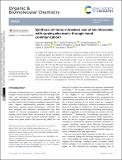Files in this item
Synthesis of mono-nitroxides and of bis-nitroxides with varying electronic through-bond communication
Item metadata
| dc.contributor.author | Giannoulis, Angeliki | |
| dc.contributor.author | Ackermann, Katrin | |
| dc.contributor.author | Bogdanov, Alexey | |
| dc.contributor.author | Cordes, David B. | |
| dc.contributor.author | Higgins, Catherine | |
| dc.contributor.author | Ward, Joshua | |
| dc.contributor.author | Slawin, Alexandra M. Z. | |
| dc.contributor.author | Taylor, James E. | |
| dc.contributor.author | Bode, Bela E. | |
| dc.date.accessioned | 2022-12-19T10:30:08Z | |
| dc.date.available | 2022-12-19T10:30:08Z | |
| dc.date.issued | 2023-01-14 | |
| dc.identifier | 282552557 | |
| dc.identifier | 52145902-f716-40e4-bb22-1fa7224755ea | |
| dc.identifier | 85144813226 | |
| dc.identifier | 000899099600001 | |
| dc.identifier.citation | Giannoulis , A , Ackermann , K , Bogdanov , A , Cordes , D B , Higgins , C , Ward , J , Slawin , A M Z , Taylor , J E & Bode , B E 2023 , ' Synthesis of mono-nitroxides and of bis-nitroxides with varying electronic through-bond communication ' , Organic & Biomolecular Chemistry , vol. 21 , no. 2 , pp. 375-385 . https://doi.org/10.1039/D2OB01863B | en |
| dc.identifier.issn | 1477-0520 | |
| dc.identifier.other | ORCID: /0000-0002-3384-271X/work/124889233 | |
| dc.identifier.other | ORCID: /0000-0002-9527-6418/work/124889240 | |
| dc.identifier.other | ORCID: /0000-0002-5366-9168/work/124889358 | |
| dc.identifier.other | PubMedCentral: PMC9811921 | |
| dc.identifier.uri | https://hdl.handle.net/10023/26622 | |
| dc.description | Funding: AG acknowledges the UK-MRBT-CDT funded by EPSRC (EP/J500045/1), BEB acknowledges the Wellcome Trust Institutional Strategic Support fund (204821/Z/16/Z), JET acknowledges the Leverhulme Trust (Early Career Fellowship; ECF-2014-005). | en |
| dc.description.abstract | Nitroxides are a unique class of persistent radicals finding a wide range of applications, from spin probes to polarizing agents, and recently bis-nitroxides have been used as proof-of-concept molecules for quantum information processing. Here we present the syntheses of pyrroline-based nitroxide (NO) radicals and give a comparision of two possible synthetic routes to form two key intermediates, namely 2,2,5,5-tetramethylpyrroline-1-oxyl-3-acetylene (TPA) and 1-oxyl-2,2,5,5-tetramethylpyrroline-3-carboxylic acid (TPC). TPC and TPA were then used as precursors for the synthesis of three model compounds featuring two distant NO groups with a variable degree of conjugation and thus electronic communication between them. Using relatively facile synthetic routes, we produced a number of mono- and bis-nitroxides with the structures of multiple compounds unambiguously characterized by X-ray crystallography, while Continuous Wave Electron Paramagnetic Resonance (CW-EPR) allowed us quantify the electronic communication in the bis-nitroxides. Our study expands the repertoire of mono- and bis-nitroxides with possibilities of exploiting them for studying quantum coherence effects and as polarizing agents. | |
| dc.format.extent | 11 | |
| dc.format.extent | 1080259 | |
| dc.language.iso | eng | |
| dc.relation.ispartof | Organic & Biomolecular Chemistry | en |
| dc.subject | QD Chemistry | en |
| dc.subject | DAS | en |
| dc.subject | MCC | en |
| dc.subject.lcc | QD | en |
| dc.title | Synthesis of mono-nitroxides and of bis-nitroxides with varying electronic through-bond communication | en |
| dc.type | Journal article | en |
| dc.contributor.sponsor | The Wellcome Trust | en |
| dc.contributor.sponsor | The Leverhulme Trust | en |
| dc.contributor.institution | University of St Andrews. School of Chemistry | en |
| dc.contributor.institution | University of St Andrews. Institute of Behavioural and Neural Sciences | en |
| dc.contributor.institution | University of St Andrews. EaSTCHEM | en |
| dc.contributor.institution | University of St Andrews. Biomedical Sciences Research Complex | en |
| dc.contributor.institution | University of St Andrews. Centre of Magnetic Resonance | en |
| dc.identifier.doi | 10.1039/D2OB01863B | |
| dc.description.status | Peer reviewed | en |
| dc.identifier.grantnumber | 204821/Z/16/Z | en |
| dc.identifier.grantnumber | ECF-2014-005 | en |
This item appears in the following Collection(s)
Items in the St Andrews Research Repository are protected by copyright, with all rights reserved, unless otherwise indicated.

